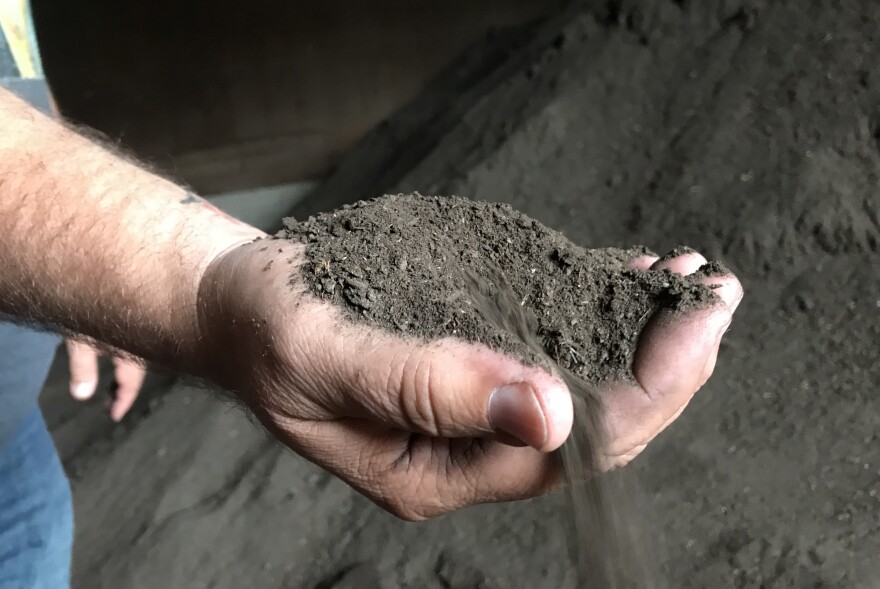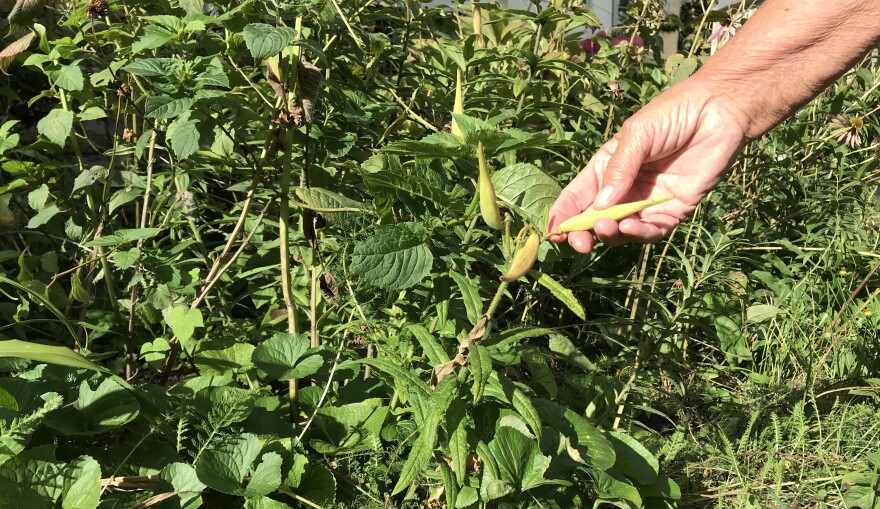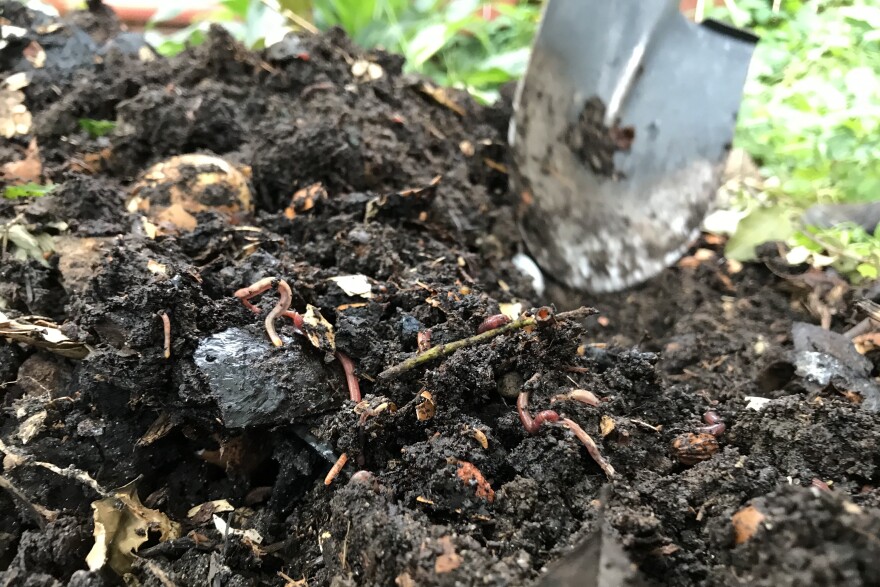Near Monroe Avenue in downtown Rochester, a lush and almost secret garden thrives.
It's filled with herbs like basil, mint, and parsley, along with plenty of flowers and berries for the bees and birds. However, not everything that grows here is by the gardener’s design.
“The squirrels have been bringing peanuts,” says 71-year-old gardener Gisele Zeigler.
She points to a little sapling: “This is a peanut plant. When it first grew, it had a peanut shell attached to one of the leaves. So I’ve got a few of those in the yard.
"And this," she says, gesturing to a mound under a canopy of foliage to the side of the garden, "is my compost!”
The compost looks like a pile of mud with leaves and food scraps mixed in. A few rotting potatoes roll to the side. Bits of eggshells stick out along the edges.
As Zeigler turns the pile with her shovel, earthworms wriggle from underneath.
“It's kind of like riches to me,” she says. “I get off on, ‘Whoo, I gotta haul these banana peels. I'm going to feed them to my plants eventually.’”
In doing so, Zeigler is diverting her food waste from the local landfill.
The FDA estimates that up to 40% of the nation’s food supply ends up as food waste. In 2010, that was over 130 billion pounds of food worth more than $160 billion.
More than 20% of trash from cities and towns is food, according to the EPA, and more food reaches landfills than any other single material in our everyday trash.
For Zeigler, composting has been a family tradition. Her parents composted food waste when she was growing up in Switzerland. And it’s a ritual that she and her sister have carried on to this day.
However, for others who want to compost, the do-it-yourself method isn’t necessarily practical or appealing. So, they take another approach.

Less than two miles from Zeigler’s garden is a temporary drop-off site for composters in the city of Rochester. It’s a free pilot program run by the city.
It pops up at Cobbs Hill Park and at Genesee Valley Park twice a week: Saturdays and Wednesdays.
It's convenient for Meghan Bosek, an elementary teacher at School 15, which is just up the road from Cobbs Hill.
“I look at my son and I think about all the different ways that our environment … is going to impact us and his life,” Bosek says. “I would just like to teach him good habits for himself, his body, and the earth and I think this is a good way to model that.”
Bosek is one of 1,000 households in the city’s program. From here, their food scraps go to a farm in Seneca Castle, about 30 miles southeast of Rochester.
This farm is where the composting company Impact Earth processes organic waste from the city's pilot program and from paying customers.
Since January, they’ve collected over 1.5 million pounds of it, which would otherwise just go into a landfill.

Composting (CO2) vs. landfilling (methane)
Ava Labuzetta, an environmental engineer with the New York State Pollution Prevention Institute, says keeping organic matter out of landfills is crucial.
When those eggshells and rotten peppers and raked leaves are thrown into plastic garbage bags and shipped off to landfills, that organic material decomposes -- but it comes at a cost.
“They break down without oxygen because they're covered with other material in the landfill, and they don't have oxygen getting to them,” Labuzetta says. “When that happens, it lets off greenhouse gases."
Of those gases, it’s mainly methane that gets released, which has 80 times the warming power of carbon dioxide, according to the Environmental Defense Fund.
It also accounts for about 20% of global carbon emissions, according to the U.S. Environmental Protection Agency.
When you’re landfilling food waste, Labuzetta says you're also landfilling all of the energy and nutrients that went into creating that food.
“So, if you think about a tomato that's gone bad, for example,” Labuzetta says. "When you landfill that, it's landfilling all of the water that was used to grow that tomato, all the energy that went into shipping that tomato from, possibly, California to where we are.”
Instead, when that food is composted, she says all those resources, in a way, are recycled back into the environment.

How composting works
There are four phases to the process: the mesophilic starting point, the high-heat thermophilic inferno, cooling, and then curing, when the compost stabilizes.
Each phase is characterized by a temperature zone. In each zone, different microscopic organisms, or microbes, thrive on the elements within the compost -- things like oxygen, nitrogen, and carbon.
While those microbes are enjoying a feast, instead of methane, carbon dioxide gas is released, along with a liquid “tea” that’s rich with nutrients. What’s left is a fertilizing soil.
It can take about a year to complete the composting process.
“If it's still getting hot inside, then you know that there's still microbial activity, that there's still material to break down,” Labuzetta says.
Patience is crucial because compost that hasn’t been fully decomposed, or “cured,” by those microorganisms can produce phytotoxins, which are harmful to plants -- and without plants, not much life can be sustained.
The fertilizer that compost can provide is a far cry from the environmental devastation that can come from landfilling that same material.

Then vs. Now
That distinct difference between composting and landfilling is something Thomas Brinson knows well.
He works on the composting site in Seneca Castle, and when he goes home, he passes by the Ontario County landfill about three miles away.
“You do have to drive in that area. And sometimes the methane is pretty bad,” Brinson says.
Brinson composts at home, so he’s familiar with the process and the occasional smell -- which can be pungent, or even putrid, sometimes with a tangy or bitter afternote -- that tells you it’s time to move it along.
“I use it for my plants,” he says. “And they've turned into a jungle since I started using (it).”
John Hicks, 88, owns the property in Seneca Castle that’s become a compost processing site. He used to be the regional director of the New York Department of Environmental Conservation.
Over the years, he’s noticed simple-enough shifts away from landfilling even seasonal waste, like in autumn when the trees become bare.
“I'm old enough to remember when everybody would rake leaves out by the front of their house and burn 'em,” Hicks says. “There were places you just would go through stifling smoke and so forth. That's not going on now.”
These days, he says that refuse takes on a new purpose. “The leaves are … food for the worms.”
Composting could be one of the biggest opportunities to reverse the human-made impacts that are driving climate change, Labuzetta says.
“There's so much environmental impact from our food supply chain and subsequent disposal of wasted food that recapturing any amount of … those nutrients and energy and putting it back into use, I think, would be hugely beneficial,” she says.
Back in the city, Zeigler says while composting can be a bit gross at times, and even attract critters if you’re not careful, it’s still better than the alternative.
“Composting for me is just like a tiny, minuscule microscopic fix that I can do,” Zeigler says. “So, I guess it's a pleasure to me and it's empowering. Hopefully, I'm not inflicting rats on my neighbors.
"But it makes me feel good.”



